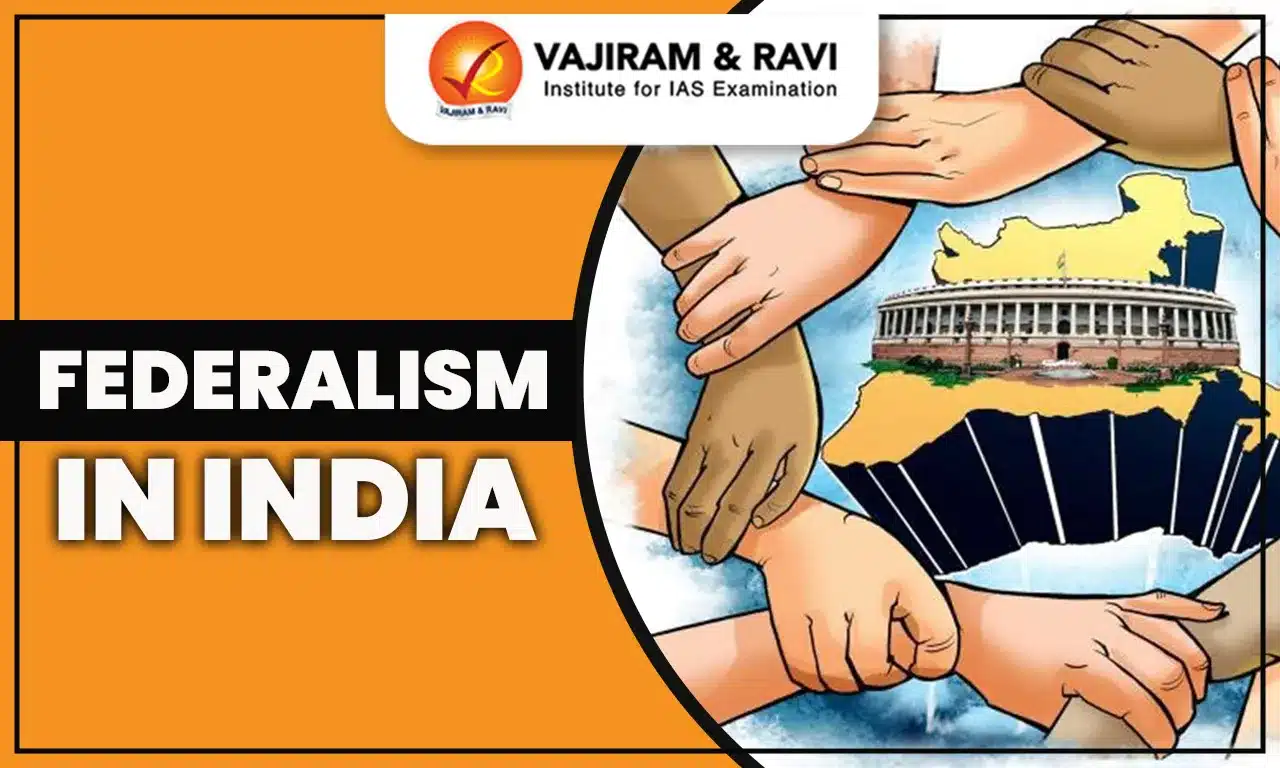What is Federalism?
Federalism refers to a system of government in which power is divided between a central authority and various constituent units, such as states or provinces.
- In India, the constitution divides powers and responsibilities between the central government and the state governments. The division of powers is further enhanced by a third tier of government, the local self-government.
- Federalism in India allows for both national unity and regional diversity, as it allows the central government to implement policies that apply uniformly throughout the country while also allowing the states to tailor policies to meet the specific needs of their regions.
What are the General Characteristics of Federalism?
The general features of federalism are
- Division of power: Federalism divides power between a central government and regional governments, with each level having its own specific responsibilities and areas of authority.
- Supremacy of Constitution: Federalism is based on a written Constitution that defines the powers and responsibilities of the central and regional governments and establishes a system of checks and balances to ensure that neither level of government becomes too powerful.
- Independent judiciary: Federalism typically includes an independent judiciary that can interpret the Constitution and resolve disputes between different levels of government.
- Bicameral legislature: Federalism often features a bicameral legislature, with one chamber representing the people and the other representing the regional governments.
- Flexibility: Federalism allows for flexibility in the sharing of powers between central and regional governments and allows for adjustments as circumstances change.
How did federalism evolve in India over time?
Federalism in pre-independent India
The current federal system in India has its roots in the Simon commission report (1930).
- The support for the federal form of government for India gained further strength during the First Round Table Conference in 1930.
- At the close of the Conference, the British Government officially accepted the principle that the form of the new Government of India was to be an All- India Federation embracing British India and the Princely States.
- Later, the Government of India Act 1935 set forth the major outlines of the federal system of government as finally evolved by the Constituent Assembly which framed the present Constitution of the Republic of India.
- In the end, the implementation of the provisions of the Act dealing with federalism was never achieved and did not become operative. However, the provisions dealing with the provinces were placed in operation and became effective in 1937.
- The Constituent Assembly which convened in 1946, officially endorsed the principle of federalism as the structure of the new India when it supported the Resolution offered by Pandit Nehru, which supported the idea of a strong autonomous province and relatively weak Centre.
- Later, this concept was altered upon the recommendation of the Union Powers Committee, which recommended that the residuary powers of Government be vested in the Centre rather than in the States.
- Therefore, at the time of independence in 1947, India was a highly centralized and unitary state, with the central government holding most powers and the states having very limited autonomy.
Federalism in post-independent India
The federal structure in post-independent India was dynamic and evolved as per the changing circumstances.
- In the 1960s and 1970s, federalism in India faced several challenges, including the rise of regional and linguistic identity politics, which led to the creation of new states and the emergence of powerful regional parties.
- This period also saw the Proclamation of National Emergency and the central government's intervention in state affairs through the imposition of the President's rule and the use of financial incentives and sanctions to influence state policy.
- In the 1980s and 1990s, the decentralization of power and the devolution of financial resources to the states became an important policy goal, and several initiatives were undertaken to empower the states and strengthen federalism. The 73rd and 74th Constitutional amendments were an important step in this direction.
- However, this process has not been without challenges, and there have been tensions between the central and state governments on issues such as revenue sharing and the allocation of resources.
- In recent years, federalism in India has faced additional challenges, including the COVID-19 pandemic, which has highlighted the importance of coordination between the central and state governments in responding to crises and addressing the needs of the people.
What is the significance of Indian federalism?
Indian federalism is significant for several reasons:
- Accommodation of diversity: Federalism in India allows for the accommodation of diversity by giving autonomy to states to govern their own affairs and address their unique needs and concerns.
- Effective governance: A robust federal structure needs to be in place to deliver effective governance and to ensure that the diverse needs and interests of the states are represented in the decision-making process.
- Promotion of democracy: Federalism promotes democracy by ensuring that power is decentralized and shared between different levels of government. This allows for greater participation and representation of citizens in the decision-making process.
- Protection of rights: Federalism allows for more robust protection of individual and minority rights as state governments are better able to address the specific needs and concerns of their diverse populations and can tailor policies and legislation accordingly.
What are the federal provisions under the Indian Constitution?
Indian Constitution establishes dual polity ( Article 1 read with Part V and Part VI) and the division of powers between them ( Article 246 read with the 7th Schedule) . The states have the same authority over the state list during ordinary times as the union has over the union list. Part VI of the Indian Constitution provides for the states of the Indian Union with independent constitutional existence.
| Article 1 | India, that is Bharat, shall be a union of states. |
| Article 79 | Parliament is constituted with two chambers, namely the Lok Sabha and the Rajya Sabha. The Rajya Sabha is designed to function as a representative body for the states in the Indian federal system. |
| Article 131 | The Supreme Court in India is independent and is the sole arbitrator of disputes between federal constituents of the centre and states. |
| Article 246 | Distribution of legislative subjects between the Union and the State governments, listed under the union, the state, and the concurrent list. |
| Article 368 | Provides for 2 types of amendment processes, making the Constitution of India a unique mixture of rigidity and flexibility. Also, the federal provisions of the Constitution can be amended with the concurrence of at least half of the state legislatures. |
What are the unitary features of the Indian constitution?
The Constitution of India has several provisions that have a unitary bias, despite the overall federal structure of the country. Some of these provisions include:
| Feature | Provisions |
| States are not indestructible |
Article 3: It gives the Parliament the power to form a new state by
|
| Emergency provisions |
Article 352: President can declare a national emergency if the country's or part of its security is threatened by war, external aggression, or armed rebellion. Article 356: It provides for President’s rule in the state where the federal relationship between the centre and state becomes unitary. |
| Strong union legislative |
Article 248:The Residuary powers of legislation rests with the parliament. Article 249: Parliament can pass a law on any matter in the State List if Rajya Sabha declares that it is necessary to do so in the national interest. Article 254: If a state law conflicts with a Parliament law regarding a topic listed in the Concurrent List, the Parliament law takes precedence and the state law is considered invalid in the areas of conflict, regardless of which law was passed first. |
| Strong union executive | Article 256: The executive power of every State shall be so exercised as to ensure compliance with the laws made by Parliament. And the executive power of the Union shall extend to the giving of such directions to a State. |
| Single citizenship | The Indian Constitution has a system of single citizenship. This means that all citizens, regardless of their state of birth or residence, have equal rights throughout the country. |
| All-India services | The All-India Services i.e. Indian Administrative Service, Indian Police Service, and Indian Forest Service, facilitate the involvement of the union government in the state executive machinery. |
| Integrated judiciary | India has an integrated judiciary with the Supreme Court at the top. And the law declared by the Supreme Court shall be binding on all courts. |
Why is Indian federalism considered Quasi-federal?
Indian federalism is called a quasi-federal structure because it exhibits features of both federal and unitary systems of government.
- The Constitution of India has a federal structure as it divides powers between the central government and the state governments.
- However, it also has certain unitary features that give the central government more power in certain situations.
- This blend of features makes the federal structure of the Indian Constitution more flexible and adaptable as per the needs.
- The Chairman of the Drafting Committee, Dr. Ambedkar, said that “Our Constitution would be both unitary as well as federal according to the requirements of time and circumstances”.
Last updated on November, 2025
→ Check out the latest UPSC Syllabus 2026 here.
→ Join Vajiram & Ravi’s Interview Guidance Programme for expert help to crack your final UPSC stage.
→ UPSC Mains Result 2025 is now out.
→ UPSC Notification 2026 is scheduled to be released on January 14, 2026.
→ UPSC Calendar 2026 is released on 15th May, 2025.
→ The UPSC Vacancy 2025 were released 1129, out of which 979 were for UPSC CSE and remaining 150 are for UPSC IFoS.
→ UPSC Prelims 2026 will be conducted on 24th May, 2026 & UPSC Mains 2026 will be conducted on 21st August 2026.
→ The UPSC Selection Process is of 3 stages-Prelims, Mains and Interview.
→ UPSC Result 2024 is released with latest UPSC Marksheet 2024. Check Now!
→ UPSC Prelims Result 2025 is out now for the CSE held on 25 May 2025.
→ UPSC Toppers List 2024 is released now. Shakti Dubey is UPSC AIR 1 2024 Topper.
→ UPSC Prelims Question Paper 2025 and Unofficial Prelims Answer Key 2025 are available now.
→ UPSC Mains Question Paper 2025 is out for Essay, GS 1, 2, 3 & GS 4.
→ UPSC Mains Indian Language Question Paper 2025 is now out.
→ UPSC Mains Optional Question Paper 2025 is now out.
→ Also check Best IAS Coaching in Delhi
Federalism in indian Polity FAQs
Q1. Is the word ‘federalism’ mentioned in the Indian constitution?+
Q2. How is Indian federalism different from that of the US?+

















